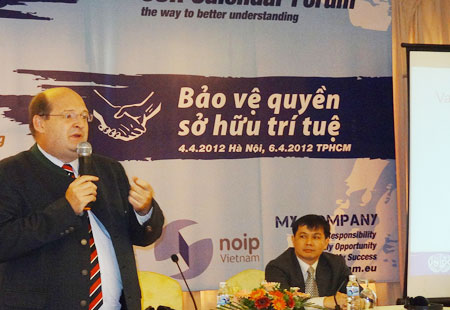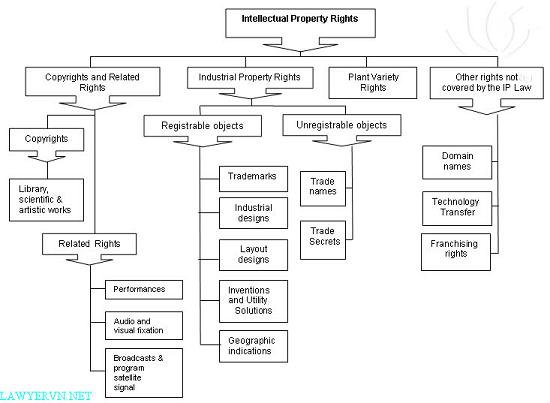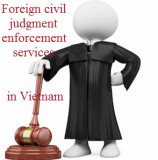Introduction to Vietnamese laws on the Intellectual Property
Vietnamese laws on comprehensive protection and management of intellectual property is enshrined in the Constitution, civil codes, law on commerce, law on intellectual property of Vietnam and international laws.
Post date: 01-12-2013
11,160 view(s)

Vietnamese laws on intellectual property rights
1. Vietnamese laws on comprehensive protection and management of intellectual property
Building on intellectual property protections are enshrined in the Constitution, the Civil Code of Vietnam 2005 (“Civil Code”) and Law on Commerce 2005 (“Commercial Law”) both took effect on 1 January 2006 and Law on Intellectual Property (“IP Law”) took effect on 1 July 2006.
The Civil Code, Commercial Law and IP Law and related implementing legislation provide a more comprehensive and detailed legal framework for the establishment and protection of intellectual property rights, including patents, marks, trade names, geographical indications, trade secrets, copyrights and “related rights”, as well as plant varieties. The current legal framework also contains prohibitions against various forms of unfair competition.
It should also be noted that the new Law on Technology Transfer, which took effect on 1 July 2007, has eased previous rules governing the transfer of technology and knowhow to Vietnamese entities and, in most cases, eliminated the requirement that that such contracts be approved in advance.
Vietnam Intellectual Property Rights Chart
Various Vietnamese Ministries are responsible for the management and protection of intellectual property:
o the Ministry of Science and Technology, via its agency the National Office of Intellectual Property (NOIP), is responsible for industrial property matters;
o the Ministry of Culture, Sports and Tourism, via the Copyright Office, is responsible for copyright matters; and
o the Ministry of Agriculture and Rural Development is responsible for plant variety matters.
International treaties and conventions
Intellectual Property is also regulated and protected through Viet Nam”s accession to various international treaties including:
the Paris Convention for the Protection of Industrial Property (since 1949);
the Berne Convention for the Protection of Literary and Artistic works (2004);
the Agreement on Trade-Related Aspects of Intellectual Property Rights;
the Madrid Agreement Concerning the International Registration of Marks (since 1949),
the Convention Establishing the World Intellectual Property Organisation (Stockholm Agreement) (since 1976)
the Patent Cooperation Treaty (since 1993).
the Convention for the Protection of Producers of Phonograms Against Unauthorised Duplication of Their Phonograms (2005);
the Convention Relating to the Distribution of Programme-Carrying Signals Transmitted by Satellite (Brussels Convention) (2006);
the Protocol Relating to the Madrid Agreement Concerning the International Registration of Marks (Madrid Protocol) (2006);
the International Convention for the Protection of New Varieties of Plants (UPOV) (2006);
the Rome Convention for the Protection of Performers, Producers of Phonograms and Broadcasting Organisations (2007).
On 11 January 2007, Vietnam became the 150th member of the World Trade Organisation (WTO). According to the terms of its accession to the WTO, Vietnam agreed to immediately comply with the terms of the Agreement on Trade-Related Aspects of Intellectual Property Rights (TRIPs). Vietnam’s domestic intellectual property legislation reflects the country’s obligations under the foregoing international treaties and conventions.
In addition, Vietnam has entered into bilateral agreements relating to the protection of intellectual property rights, including the Agreement Between the Government of the United States of America and the Government of the Socialist Republic of Vietnam on the Establishment of Copyright Relations (1998), a bilateral treaty for the protection of intellectual property rights with Switzerland (1999), as well as the Agreement Between the United States of America and the Socialist Republic of Vietnam on Trade Relations, which took effect on 10 December 2001.
Vietnam is not a party to the Nice Agreement Concerning the International Classification of Goods and Services for the Purposes of the Registration of Marks (“Nice Agreement”). However, Vietnam follows the international system of classifying goods and services prescribed in the Nice Agreement.
2. Vietnamese intellectual property laws on copyright and relted rights
|
Copyright and relted rights |
Works protected by copyright law in Viet Nam are similar to those covered in other jurisdictions and include: o Literary, artistic and scientific works, including textbooks, lectures and speeches, works of the press, musical, theatrical and cinematographic works, works of applied art, photographic works, architectural works, maps, sketches and similar drawings, works of folklore and folk art, as well as computer programs. o Derivative works may also be protected if this would not prejudice the copyright in the pre-existing work used to create the derivative work. |
Pursuant to Vietnam’s obligations under international treaties and conventions and corresponding provisions of the IP Law, protection is also provided to “related rights”, including rights in performances of musical, choreographic, theatrical, literary and other artistic works, sound and video recordings, as well as broadcasts and satellite signals carrying coded programs.
Although copyright is automatic on creation, a system of registration also exists. Registration of copyright is not required for a work to be protected in Vietnam. However, registration relieves the registrant of the burden of proving copyright or a “related right” in some cases. Registrations are processed by the Copyright Office under the Ministry of Culture, Sports and Tourism, with the certificates issued being valid proof of copyright ownership in Viet Nam. Copyright registrations are also recorded in a National Register of Copyright and Associated Rights. Contracts assigning or licensing copyright must be in writing and comply with specific requirements set out in the Law on Intellectual Property.
“Moral Rights” and “Economic Rights”
Copyright consists of “moral rights” and “economic rights”
Moral rights (except for the moral right to publish or authorise others to publish the work) are protected definitely indefinitely.
Economic rights in copyrighted works (and the moral right to publish or authorise others to publish the work) are protected for the life of the author plus fifty (50) years, except for cinematographic, photographic, dramatic and other specified works which are protected for fifty (75) year from the date of first publication.
3. Vietnamese intellectual property laws on industrial property rights
|
Industrial property rights |
3.1 Inventions (patents)
3.2 Industrial designs: |
3.4 Trade marks
Trademarks are protected in Viet Nam once they have been registered with the NOIP or they have been accepted for protection by the NOIP having been filed through the Madrid System, designating Viet Nam. There are also specific provisions for ”well-known” marks.
o Consistent with international practice, trademarks are registered in relation to particular goods and services.
o The term of protection is 10 years (renewable for consecutive 10 year terms) and international standard ”first to file” and ”priority” principles apply.
Contracts for assignment of industrial property rights (including trademarks and invention patents) must be registered with NOIP. Licences of industrial property do not have to be registered, but will be enforceable against third parties only if registered.
3.5 Trade names
A trade name that is capable of distinguishing the business in connection with which it is used (i.e. that is not confusingly similar to another party’s mark or geographical indication which was protected before the date of first use of the trade name) is protected from the date it is first used in Vietnam.
3.6 geographical indications
A geographical indication is protectable in Vietnam if the product bearing the name comes from the location that corresponds to the geographical indication and the reputation, quality or characteristics of the product is principally attributable to the geographical conditions of that location. Geographical indications are protectable indefinitely from the date a title of protection is granted.
3.7 Trade secrets
A trade or business secret is protectable as such if it satisfies the criteria for protection, namely, that the trade secret is not commonly known or easily ascertainable, it gives its holder a commercial advantage over others, and the owner takes such steps as are necessary to keep the trade secret confidential and not easily accessible.
4. Vietnamese intellectual property laws on Plant varieties
|
Intellectual property on Plant varieties |
Plant varieties are protected for a period of 25 years from the date a title of protection is granted in the case of timber trees and vines, and 20 years for other varieties of plants. The recent amendments to the IP Law include specific definitions for “reproductive materials” and “harvested materials” and Article 186 of the IP Law was amended to state that protected rights to a plant variety “shall also apply to harvested materials generated from unlawful use of reproductive materials of the protected plant variety.” This amendment is intended to bring the IP Law into closer line with the UPOV. |
5. Establishment of intellectual property rights
To obtain protection for patents (invention patents, utility solution patents and industrial design patents), layout designs of semi-conductor integrated circuits, marks, geographical indications and plant varieties, an application must be filed with the State administrative body responsible for the intellectual property right in question. In the case of patents, layouts, marks and geographical indications, an application must be filed with the National Office of Intellectual Property (“NOIP) under the Ministry of Science and Technology.
Applications for protection of plant varieties are submitted to the Office for the Protection of New Plant Varieties under the Ministry of Agriculture and Rural Development.
Subject to Vietnam’s obligations under applicable treaties, including its obligation to honor priority dates and protect well known marks, Vietnam follows the “first to file” principle in connection with granting titles of protection to patents, layout designs of semi-conductor integrated circuits, marks, geographical indications.
Foreign individuals and entities must retain a local Vietnamese agent to submit an application for protection of intellectual property rights and provide the Vietnamese agent with a power of attorney.
6. Vietnamese intellectual property laws on domain names
New domain name dispute regulations took effect in February 2009 in the form of Circular No. 10/2008/TT-BTTTT (“Circular 10”) dated December 24, 20008 Providing for the Settlement of Disputes Involving Vietnam Country Code Domain Names “.vn” and Circular No. 9/2008/TT-BTTTT (“Circular 9”) Guiding the Management and Use of Internet Resources.
Circular 10 provides a basis for challenging another party’s ownership of a <.vn> domain name in terms that reflect the more widely recognised notion of “cyber squatting” found in the Uniform Domain Name Dispute Resolution Policy (UDRP).
Under Circular 10, the plaintiff must show that (i) the disputed domain name is identical or confusingly similar to a trade name or trademark in which that party has lawful rights or interests, (ii) the domain name owner has no lawful rights or interests in the domain name, and (iii), the domain name was registered and is being used in bad faith, i.e., with malicious intent.
Circular 9 provides that disputes involving domain names that arise in civil or commercial relationship between parties should be resolved in accordance with the Law on Technology and Information which states that domain name disputes shall be resolved through (i) informal negotiations or conciliation, (ii) arbitration or (iii) civil proceedings in Vietnamese court. Under the IP Law, it is also an act of unfair competition to register, possess or use a domain name that is identical or confusingly similar to a protected trade mark (including a well known mark), trade name or geographical indication of another.
7. Enforcement of intellectual property rights
In cases of counterfeiting or other infringement of intellectual property rights (“IPR”), the law Law on Intellectual Property provides intellectual property right holders whose rights are infringed with options of civil, administrative, criminal and customs remedies.
o Civil remedies include preliminary injunctions to seize, collect and preserve evidence of infringement as well as compensation for damages caused by infringement.
An IPR owner may also seek relief by filing a civil action in Vietnamese court pursuant to the Civil Proceedings Code, which was adopted on 15 June 2004. The Vietnamese court may order the defendant to cease and desist from its infringing activity, issue a public apology, perform specified civil obligations and compensate the IPR owner for economic and psychological damage. Upon showing that there is a risk of irreparable damage to the IPR owner or that suspected infringing goods or evidence may be destroyed or lost, the IPR owner may seek preliminary or provisional relief in the form of, amongst others, seizure or sealing of the infringing goods. In the event such relief is granted, the IPR owner must post security in an amount 20% of the value of the goods seized or detained, or at least VND20 million (about US$1,000). The IPR owner will be required to compensate the defendant in the event the goods are found to be not infringing.
o Administrative sanctions (including confiscation, warnings or fines) may be imposed by inspectorates, police officers, market management offices, customs officers and People”s Committees.
In the case of administrative enforcement, the IPR owner typically enlists the assistance of the Market Management Bureau (“MMB”) and/or the Economic Police in the locale(s) where the infringing activity is taking place. The infringer shall be compelled to cease the infringing acts and shall receive a warning or monetary fine at least equal to the value of the infringing goods, but no more than five times the value of the infringing goods. Counterfeit goods may also be confiscated, together with the raw materials, equipment and means used to produce them. In addition, counterfeit goods may be ordered destroyed, distributed through no-commercial channels, or transported or re-exported out of Vietnam after the infringing elements of the goods have been removed. As noted above, the IPR owner may also request the assistance of Vietnamese customs by providing information necessary for Vietnamese customs to identify and seize the infringing goods.
One of the recent amendments to the IP Law will make the imposition of administrative fines subject to the Ordinance on Handling Administrative Violation (“the Ordinance”). Under the Ordinance, the maximum fine that can be imposed for infringement of IP right is Vietnamese Dong (“VND”) 500 million (approximately US$25,000). That is, once the amendments take effect on 1 January 2010, administrative fines based on the value of the infringing goods will no longer apply.
o Criminal sanctions (including imprisonment) can apply for breaches causing ”serious” consequences. The infringer may be criminally prosecuted and subjected to fines, imprisonment and even the death penalty, depending on the severity of the infringement.
o Customs” intervention at Viet Nam”s borders can include provisional suspension of customs procedures for imported or exported goods suspected of infringing intellectual property rights.
8. Technology transfer
In addition to provisions in the Civil Code and Commercial Law on technology transfer, Vietnam adopted a new Law on Technology Transfer, which took effect on 1 July 2007.
In an effort to promote the development, use and dissemination of advanced technology throughout Vietnam for the socio-economic development of the country, the Law on Technology Transfer and related legislation has substantially eased previous rules governing the transfer (by assignment, license or contribution to capital) of technology, know-how and proprietary rights by foreign parties to Vietnamese parties, while at the same time allowing the parties to a technology transfer contract much greater freedom to determine the terms of their agreement, including the form and amount of payment for such technology transfer.
Technology subject to transfer includes technical know-how, technical information, such as technological plans, processes, solutions, formulae, specifications, drawings and computer programs, as well as methods for optimizing production and renovating technology. Technology to be transferred may be embodied or bundled with proprietary rights such as patents, trade marks, or trade secrets, whether or not such rights are protected in Vietnam.
Transfers of technology are encouraged if, for example, they create new and highly competitive products, new industries or services, save energy or raw materials or protect human health. Transfers of technology are restricted if directed at the protection of the national interest, human health, Vietnamese cultural values or protection of living organisms, natural resources or the environment. Transfers of technology are prohibited if they are inconsistent with laws on occupational safety, protection of human health or the environment, or if the technology transferred creates products that harm Vietnam’s socio-economic development, national defense, security or safety, or if the technology is a State secret.
The Law on Technology Transfer permits technology to be transferred in the form of:
a stand alone technology transfer contract;
in connection with an investment project (e.g. as part of a party’s contribution to capital, provided this is documented in writing,
as part of a franchising agreement,
as part of a contract transferring/licensing industrial property rights, or
a contract for the sale of machinery with which a transfer of technology is associated.
A technology transfer contract must be in writing, which can include a telegram, telex, facsimile, message or other form authorised by law.
The law expressly distinguishes between transfers of ownership of technology and transfers of the right to use technology.
A contract for the transfer of restricted technology shall be effective only if first approved by the competent State body.
A technology transfer contract must be registered with the “competent State body” in cases provided by law.
A Vietnamese and foreign party may agree to apply foreign law or international commercial practice to the technology transfer contract (provided this is not contrary to fundamental principles of Vietnamese law), and even provide for disputes to be resolved by a foreign arbitrator or court.
9. Franchising
A common way to commercially exploit a trade mark and related intellectual property rights and know-how is through franchising.
With the adoption of the Commercial Law and related implementing legislation, the franchise form of doing business now has a specific legal basis. General provisions of the Commercial Law on franchising have been supplemented by Decree No. 35-2006-ND-CP Implementing in Detail the Commercial Law With Respect of Franchising Activities (“Decree 35”), which provides more specific legal provision governing franchising.
While providing the franchisor and franchisee a significant degree of freedom to contract, the legal framework for franchising in Vietnam, like in other countries, recognises the need for a certain amount of regulatory oversight of the franchising business. In this regard, Decree 35, among other things:
o Requires the franchisor to have operated its franchise system for a least one year before granting a franchise in Vietnam, and if the franchisor’s principal or primary is a Vietnamese business entity, this franchisee must operate the franchise for at least one year before sub-franchising the franchise system;
o Requires that the franchise system be registered with the Ministry of Trade;
o Requires the franchisor to provide the prospective franchisee with a disclosure document at least fifteen 15 days before the parties enter a franchise contract. (The Ministry of Trade has issued regulations regarding information that must be contained in the disclosure document and information that may be disclosed voluntarily.)
Lawyer Vietnam Law Firm


















Send your comment